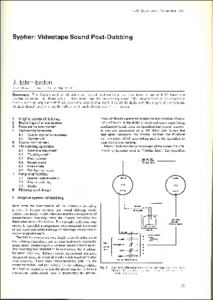Although TV is a visual medium, a television programme broadcast without without good quality audio is not acceptable. There are dialogues, music, original or wild sound; all make a package for a complete television broadcast.
So Sound is an element that is just as important as good quality visual images in television production. The audience might forgive a blurry, out of focus image (for a specific shot) but they are unlikely to forgive bad sound because if they can’t clearly hear what a person is saying, then they are not going to be to engaged with what the characters are talking about. This was make very clear in a BBC production of “Jamaica Inn” (2014): this programme attracted a great deal of attention – for all the wrong reasons. The dialogue in “Jamaica Inn” was very difficult to hear – a combination of the actors and actresses “mumbling”, radio mics buried beneath layers of clothing and an incorrect mix down from Dolby 5.1 (for DVD) to stereo (for TV transmission).
Every Broadcasting organisation needs people, at all stages of the production of a programme, to look after the sound and visual quality, working as a team, to produce not just intelligible sound, but excellent sound.
 |
Equalization for Tape Recording and Reproduction |
This article makes a comparison between the equalization requirements of magnetic tape (audio) recording and reproducing systems to comply with British or American Standards. The various factors which limit both the recording and replay response are detailed and a number of suitable equalizer circuits are described and analysed. Finally, the various methods of measuring the surface induction on a recorded tape are detailed. The article includes circuits of transistorized recording and replay amplifiers which have proved satisfactory in operation.
|
 | SYPHER: Videotape Sound Post-Dubbing |
| SYPHER was developed by John Edon-Eaden in the days of 2″ quad VTR when sound post-production work was possible but not convenient. Before SYPHER, the programme was edited and then the tape was played back via a suitable sound suite and recorded on a second 2″ VTR. It was possible to stop and pick-up but this was avoided if possible. In essence, the sound dub was recorded ‘as live’ It was expensive (2 x 2″ Quad VTs plus operators). After final review the sound from the copied tape was transferred back, sound only, to the master tape. This way, there were no further generations of pictures which became obvious after more than 2 or 3 iterations.
When timecode was developed, off-line sound dubbing became possible. Timecode uniquely identified each frame of the master VTR. Synchronisers (not video for picture mixing) were then used to lock a multi-track audio recorder to a low quality helical-scan VTR (initially reel-to-reel but later a U-Matic cassette format). This way, the use of 2″ machines was much reduced
|
Back to top
Back to reprint index



